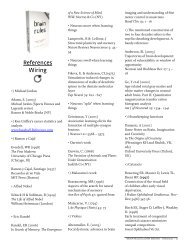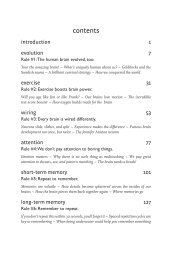Brain Rules for Baby Media Kit (PDF)
Brain Rules for Baby Media Kit (PDF)
Brain Rules for Baby Media Kit (PDF)
Create successful ePaper yourself
Turn your PDF publications into a flip-book with our unique Google optimized e-Paper software.
BRAIN RULES FOR BABYHow to Raise a Smart and Happy ChildFrom Zero to FiveBy Dr. John MedinaBook DetailsOctober 12, 2010 - Parenting - Hardcover320 pages - 6 1/8" x 9 1/4"$27.99 US/$29.99 CANISBN-13: 978-09797777-5-2Also available on audio book (CD - unabridged)ISBN-13: 978-09797777-6-9Contact In<strong>for</strong>mationBooksellers: Please contact your Perseus sales rep,or call 800.343.4499.For publicity: Contact Tammy Richards-LeSure817.453.6166 / richardspr@charter.netor Andrew Palladino917.848.7480 / ampalladino@gmail.comFor all other inquiries: Contact Mark Pearson206.730.2463 / mark@pearpress.comWebsitewww.brainrules.net
FOR IMMEDIATE RELEASEContact: Tammy Richards-LeSure817-453-6166; richardspr@charter.netContact: Andrew Palladino917-848-7480; ampalladino@gmail.com“...a writing style that makes words leap off the page.”—USA TODAY (Review of <strong>Brain</strong> <strong>Rules</strong>)“The greatest pediatric brain-boosting technology in the world is probably a plan cardboard box, a fresh box ofcrayons, and two hours. The worst is probably your new flat-screen TV.”— Dr. John Medina, from the introduction of <strong>Brain</strong> <strong>Rules</strong> <strong>for</strong> <strong>Baby</strong>From the New York Times Bestselling Author of <strong>Brain</strong> <strong>Rules</strong>How to Raise a Smart and Happy Childfrom Zero to FiveBy Dr. John MedinaWhy is leaving your baby alone during the first part of pregnancy so important? Why is facetime with Mom so crucial to maximizing your child’s potential and screen time so damaging?What can you do to give your child the best chance at being smart and happy?Scientists know.Following the success of his long-running New York Times bestseller <strong>Brain</strong> <strong>Rules</strong>, JohnMedina, renowned developmental molecular biologist at the University of Washington Schoolof Medicine and director of the <strong>Brain</strong> Center <strong>for</strong> Applied Learning Research at Seattle PacificUniversity, brings us BRAIN RULES FOR BABY: How to Raise a Smart and Happy Childfrom Zero to Five (Pear Press/Perseus Books Group; October 12, 2010; $27.99).The book combines all the latest science on how best to develop your baby’s brain. Just oneof the surprises: The best way to get your children into the college of their choice? Teachthem impulse control.Bridging the gap between what scientists know and what parents practice, each chapterdescribes brain rules — what scientists know <strong>for</strong> sure about how the early childhood brainworks. The book presents the science behind the rules while offering practical ways <strong>for</strong>parents to apply the research. Medina, a dedicated father himself, shares his passion <strong>for</strong>brain science and <strong>for</strong> raising children, making the book easily accessible with humor,fascinating stories, and enlightening case studies throughout. Each chapter ends with asummary of key points.- Over -
Just a few of the key points you’ll learn along the way:We are just starting to learn what good parenting looks like.Every kid is different and every parent is different. Every brain is wired differently.The best advice neuroscience can give a woman in the first half of pregnancy? Do nothing.Pregnant moms inhale parenting in<strong>for</strong>mation while pregnant but it is just as important toreturn later <strong>for</strong> more. What you do in your child’s first five years of life—not just the firstyear—profoundly influences how he or she will behave as an adult.The brain’s chief job description — yours, mine, and your hopelessly adorable children’s — isto help our bodies survive another day. That colors everything.The greatest pediatric brain-boosting technology in the world is probably a plain cardboardbox, a fresh box of crayons, and two hours.Exposing your infant or toddler to language DVDs can actually reduce his vocabulary.Babies need to feel safe above all. Developing an “empathy reflex” with your spouse gives youthe highest probability of raising smart, happy, morally aware kids.Telling your children they are smart will actually make them less willing to work on challengingproblems. If you want to get your baby into Harvard, praise her ef<strong>for</strong>t instead.The best predictor of academic per<strong>for</strong>mance is not IQ. It’s self-control.The greatest predictor of happiness is having friends. Making and keeping friends requiresbeing good at deciphering nonverbal communication. Learning a musical instrument booststhis ability by 50 percent. Text messaging may destroy it.Children have an inborn sense of right and wrong that is remarkably similar around the world.Children are happiest if their parents are demanding and warm.In his cutting edge new book, John Medina unravels how the brain develops from the wombthrough the early years, with practical advice from the perspective of a brain scientist andfather. He’s put it all into BRAIN RULES FOR BABY, an indispensible guide <strong>for</strong> parents.For the <strong>Brain</strong> <strong>Rules</strong> <strong>for</strong> <strong>Baby</strong> film trailer, video clips, high-resolution photos, excerpts fromthe audio book and more, visit: www.brainrules.net.# # #About the Author:John J. Medina is a developmental molecular biologist and research consultant. He is the author ofthe long-running New York Times bestseller, <strong>Brain</strong> <strong>Rules</strong>: 12 Principles <strong>for</strong> Surviving and Thriving atWork, Home, and School. He is an affiliate professor of bioengineering at the University of WashingtonSchool of Medicine. He is also the director of the <strong>Brain</strong> Center <strong>for</strong> Applied Learning Research at SeattlePacific University. Medina lives in Seattle, Washington with his wife and two boys.RAIN RULES FOR BABY:How to Raise a Smart and Happy Child from Zero to FiveA Pear Press/ Perseus Books Group HardcoverPublication Date: October 12, 2010ISBN: 978-09797777-5-2; Pages: 304; Price: $27.99Visit: www.brainrules.netAlso available on audio book (CD - unabridged)ISBN-13: 978-09797777-6-9Publicity contactsTammy Richards-LeSure: 817-453-6166; richardspr@charter.netAndrew Palladino: 917-848-7480; ampalladino@gmail.com
THE RULESFROM BRAIN RULES FOR BABYPREGNANCYBabies develop an active mental life in the wombStressed mom, stressed babyEat right, stay fit, get lots of pedicuresRELATIONSHIPHappy marriage, happy babyThe brain seeks safety above allWhat is obvious to you is obvious to youSMART BABY: SEEDSThe brain cares about survival be<strong>for</strong>e learningIntelligence is more than IQFace time, not screen timeSMART BABY: SOILSafe baby, smart babyPraise ef<strong>for</strong>t, not IQGuided play—every dayEmotions, not emoticonsHAPPY BABY: SEEDSBabies are born with their own temperamentEmotions are just Post-it notesEmpathy makes good friendsHAPPY BABY: SOILThe brain craves communityEmpathy soothes the nervesLabeling emotions calms big feelingsMORAL BABYBabies are born with moral sensibilitiesDiscipline + warm heart = moral kidLet your yes be yes and your no be noPublicity contactsTammy Richards-LeSure: 817-453-6166; richardspr@charter.netAndrew Palladino: 917-848-7480; ampalladino@gmail.com
ABOUT JOHN MEDINAAUTHOR OF BRAIN RULES FOR BABYJOHN J. MEDINA is a developmental molecularbiologist focused on the genes involved in humanbrain development and the genetics of psychiatricdisorders. He has spent most of his professionallife as a private research consultant, workingprimarily in the biotechnology and pharmaceuticalindustries on research related to mental health.Medina holds joint affiliate faculty appointments atthe University of Washington School of Medicine, inits Department of Bioengineering, and at SeattlePacific University, where he is the director of the <strong>Brain</strong> Center <strong>for</strong> Applied LearningResearch.Medina was the founding director of the Talaris Research Institute, a Seattle-basedresearch center originally focused on how infants encode and process in<strong>for</strong>mation atthe cognitive, cellular, and molecular levels.In 2004, Medina was appointed to the rank of affiliate scholar at the NationalAcademy of Engineering. He has been named Outstanding Faculty of the Year at theCollege of Engineering at the University of Washington; the Merrill Dow/ContinuingMedical Education National Teacher of the Year; and, twice, the BioengineeringStudent Association Teacher of the Year. Medina has been a consultant to theEducation Commission of the States and a regular speaker on the relationshipbetween neurology and education.Medina’s books include: BRAIN RULES FOR BABY: How to Raise a Smart andHappy Child from Zero to Five (Pear Press/ Perseus Books Group, October 12,2010), <strong>Brain</strong> <strong>Rules</strong> (New York Times Bestseller), The Genetic Inferno, The Clock ofAges, Depression, What You Need to Know About Alzheimer’s, The Outer Limits ofLife, Uncovering the Mystery of AIDS, and Of Serotonin, Dopamine and AntipsychoticMedications. Medina is also the regular “Molecules of the Mind” contributingcolumnist <strong>for</strong> Psychiatric Times.Medina has a lifelong fascination with how the mind reacts to and organizesin<strong>for</strong>mation. As the father of two boys, he has a passion <strong>for</strong> how the brain sciencesmight influence the way we teach our children. In addition to his research,consulting, and teaching, Medina speaks often to public officials, business andmedical professionals, school boards, and nonprofit leaders. He lives in Seattle,Washington with his wife and sons.For more in<strong>for</strong>mation, visit: www.brainrules.net.Publicity contactsTammy Richards-LeSure: 817-453-6166; richardspr@charter.netAndrew Palladino: 917-848-7480; ampalladino@gmail.com
TALKING POINTS FOR DR. JOHN MEDINAAUTHOR OF BRAIN RULES FOR BABYPREGNANCYBabies develop an active mental life in the womb. The best advice neurosciencecan give a mother-to-be in the first half of pregnancy? Do nothing. Don’t waste yourmoney on products claiming to improve a preborn baby’s IQ, temperament, orpersonality. None of them has been proven to work. In the first half of pregnancy,babies mostly want to be left alone. That’s when their brains are creating an astonishing 8,000neurons per second. In the second half of pregnancy, babies begin to perceive and process agreat deal of sensory in<strong>for</strong>mation. They can smell the perfume you wear and the garlic on thepizza you just ate. Here, a baby’s brain begins wiring thousands of connections together—a jobthat’s not finished <strong>for</strong> another couple of decades. From touch to sight to sound, a baby developsan incredibly active mental life in the womb.Stressed mom, stressed baby. Get a rocking chair and find a quiet, com<strong>for</strong>table place torelax. One factor in a child’s temperament and IQ is how stressed you felt while pregnant.Eat right, stay fit, get lots of pedicures. The mother-to-be can boost her baby’s braindevelopment in four ways: proper weight gain (take in an extra 300 calories a day), a balanceddiet of fruits and vegetables (along with enough folic acid, pediatricians suggest eating foodsrich in iron, iodine, vitamin B12 and omega-3), moderate exercise (30 minutes of aerobicexercise each day), and stress reduction (excess stress can do damage to you and the baby).RELATIONSHIPHappy marriage, happy baby. More than 80 percent of couples experience a hugedrop in marital quality during the transition to parenthood. That’s a surprise to manyrookie parents. The four most common sources of marital turbulence are: sleep loss,social isolation, unequal distribution of household workload, and depression. Work onyour marriage and you’ll be able to better navigate this as a team. Schedule sex regularly,address your sticking points, and deliberately reconcile in front of your children.The brain seeks safety above all. Children are highly attuned to whether their environment issafe; even infants younger than 6 months can detect and respond to hostility between parents.But if you develop an “empathy reflex” with your spouse, your marriage is nearly divorce-proof.You enjoy the highest probability of raising smart, happy, morally aware kids.What is obvious to you is obvious to you. When fighting, people tend to believe they areperfectly unbiased, in<strong>for</strong>med, and objective, while simultaneously thinking their spouses arehopelessly prejudiced, clueless, and subjective. “Perceptual asymmetry” can lead to some nastyfights. Guess what? Other people can’t read our minds. Empathy reduces hostility. Here’s how:1. Describe the emotional changes you think you see. 2. Make a guess as to where thoseemotional changes came from.SMART BABY: SEEDSThe brain cares about survival be<strong>for</strong>e learning. Parents think a child’s brain loveslearning. That’s not accurate. The brain is interested in surviving. Every ability in ourintellectual tool kit was engineered to escape extinction. It is only a happy coincidencethat our intellectual tools confer on us the ability to create spreadsheets and speakFrench. We do not survive so that we can learn. We learn so that we can survive.-Over-
Intelligence is more than IQ. By “smart,” most parents mean they want their kids to do wellin school. But true intelligence looks different in every kid. IQ is related to several importantchildhood outcomes, but it is only one measure of intellectual ability. Human intelligence hasmany ingredients including self-control, the desire to explore, inquisitiveness, creativity, andverbal and nonverbal communication. All of these are, to some extent, controlled by genetics.(The DNA you give your kids controls about 50% of their intellectual horsepower.) And many ofthem are characteristics common among the country’s most successful entrepreneurs.Face time, not screen time. Babies love to gaze at human faces. Mom’s is best of all. TVbe<strong>for</strong>e age 2 is harmful to children. Every hour of TV creates a greater likelihood of attentionproblems and bullying once your child starts school. Activities likely to hurt early learning includeoverexposure to television, hyperparenting, and being sedentary. One of the best things you cando <strong>for</strong> your baby’s brain power is devote lots of time to playing, in a certain way (see “Guidedplay” below). Surprisingly, it builds self-control.SMART BABY: SOILSafe baby, smart baby. The brain will never outgrow its preoccupation withsurvival. There are four nutrients you want in your behavioral fertilizer, adjusting asyour baby gets older: breastfeeding, talking to your baby, guided play, and praisingef<strong>for</strong>t rather than accomplishment. Breast-feed <strong>for</strong> one year. Longer is better. You’llget a smarter baby, a healthier baby, a happier baby. The benefits of breast-feeding are some ofthe most well-established, practical, and brain-boosting we know. Describe everything you see.Talk to your baby a lot. This is as simple as saying, “It’s a beautiful day” when you look outsideand see the sun. Just talk. At infancy, do so in “parentese,” those clusters of exaggerated vowelsounds at high frequencies. A rate of 2,100 words per hour is the gold standard.Praise ef<strong>for</strong>t, not achievement. Praise your child’s ef<strong>for</strong>t (“I’m proud of you. You reallyworked hard on that”) rather than innate ability (“You’re so smart!”). Avoid hyperparentingbecause it just doesn’t work. Viewing a child’s development like a competitive race creates thekind of stress that actually damages the brain. Pressuring children to learn a subject be<strong>for</strong>e theirbrains are ready does not work. When children who are praised <strong>for</strong> their ef<strong>for</strong>t fail, they aremuch more likely to try harder.Guided play—every day. Open-ended activities are as important to a child’s neural growth asomega-3s. Kids allowed a specific type of open-ended play time are more creative, better atlanguage, better at problem solving, less stressed, better at memory, and more socially skilled.The secret sauce is called mature dramatic play. Children create a play plan and are coached onpretending, among other things, and this helps build impulse control. MDP has been codified intoa school program called Tools of the Mind, one of the few programs of its type that has beenstudied in randomized trials. Every playroom should have the following design element: lots ofchoices. A place <strong>for</strong> drawing. A place <strong>for</strong> painting. Musical instruments. A wardrobe hanging withcostumes. Blocks. Picture books. Tubes and gears. Anything where a child can be safely letloose, joyously free to explore whatever catches her fancy.Emotions, not emoticons. Could texting be related to social immaturity? The averageyoungster in 2008 sent and received about 80 texts a day. In 2009, 27 percent of the wordsthey encountered came directly from a computer. The problem is, interpreting nonverbal cues iscritical, and texting doesn’t offer any practice doing it. Flesh-and-blood people touch each other,get in each other’s way, and constantly telegraph in<strong>for</strong>mation to each other in a fashion noteasily re<strong>for</strong>matted into emoticons and cute three-letter abbreviations. The less practice humansget at it, the more immature their social interactions are likely to be, which has implicationsranging from future divorce rates to erosion of productivity in the work<strong>for</strong>ce. The phenomenon istoo new <strong>for</strong> definitive conclusions. The best current advice may be keeping those machinesmostly in the off position <strong>for</strong> as long as you can.-More-
HAPPY BABY: SEEDSBabies are born with their own temperament. Children are born with certainpredispositions, which you’ll be able to see in your baby’s first few minutes of life, butthere is no one gene responsible <strong>for</strong> temperament.Emotions are just Post-it notes. Emotions act like Post-it notes, helping the brain identify,filter, and prioritize. Children who learn to regulate their emotions have deeper friendships, andare thus happier, than those who don’t. No single area of the brain processes all emotions.Empathy makes good friends. After decades of research burning through millions of dollars,scientists have uncovered this shocker of a fact: We are most likely to maintain deep, long-termrelationships with people who are nice. Many ingredients go into creating socially smart children.A big one is the ability to empathize with the needs of another person. Your child must cultivatethe ability to peer inside the psychological interiors of someone else, accurately comprehendthat person’s behavioral reward and punishment systems, and then respond with kindness andunderstanding. This is empathy. Individuals who are thoughtful, kind, sensitive, outwardfocused, accommodating, and <strong>for</strong>giving have deeper, more lasting friendships—and lowerdivorce rates—than people who are moody, impulsive, rude, self-centered, inflexible, andvindictive. A negative balance on this spreadsheet can greatly affect a person’s mental health,too, putting him at greater risk <strong>for</strong> depression, anxiety disorders, and fewer friends. Those withemotional debits are some of the unhappiest people in the world.HAPPY BABY: SOILThe brain craves community. The single greatest predictor of happiness is havingfriends. This takes years of practice. Kids consistently exposed to the delightfulrough and tumble of other children get experience with many personalities. Thatmeans arranging plenty of play dates. Let your children interact with multiple agegroups, too, and a variety of people. But pay attention to how much your child can handle atone time. Social experiences must be tailored to individual temperaments.Empathy soothes the nerves. When the brain perceives empathy, the vagus nerve relaxesthe body. This nerve connects the brainstem to other areas of the body, including the abdomen,chest, and neck. When it is overstimulated, it causes pain and nausea. Develop an empathyreflex with your children. When faced with a strong emotion, turn to empathy first. Describe theemotion you think you see. Make a guess as to where it came from. Remember, understandingsomeone’s behavior is not the same thing as agreeing with it. It is just your opening response toany situation, especially when intense emotions are involved. If you want your children to bemore empathic, they will need to see it modeled on a regular basis. Empathy comes from beingempathized with.Labeling emotions calms big feelings. How you deal with your child’s emotions — theintense, inappropriate ones — fundamentally affects your child’s happiness. Actually, it affectseverything from their self-calming ability to rates of violence to parental loyalty to infectiousdiseases. One trick: teaching your child to label emotions. It helps connect the nonverbal andverbal pathways in the brain. Another is empathizing, which calms the nervous system.Emotions should be acknowledged and named but not judged. Chart your child’s emotionallandscape. Most infants have a limit to how much stimulation they can take at any one time.Make a list of your baby’s “can we stop now?” cues, which can be as subtle as head-turning oras obvious as bawling. Then get into a rhythm based on that, interacting in response to yourbaby’s cues, withdrawing when she’s had enough. Continue to monitor your child’s emotions ashe or she gets older. Jot down a few sentences describing your child’s likes and dislikes. Updateit continuously as various emotional responses develop. Making a list gets you in the habit of-Over-
paying attention, and it provides a baseline, allowing you to notice any changes in behavior. Bewilling to enter into your child’s world on a regular basis and to empathize with what your childis feeling. Simple as a song. Complex as a symphony. The behaviors of good parenting followfrom this attitude. If you also create a set of rules and en<strong>for</strong>ce them with consistency andwarmth, you have virtually everything you need to start your parenting journey.MORAL BABYBabies are born with moral sensibilities. Wondering how to raise a morally awarechild? Your child has an inborn sense of right and wrong that is remarkably similar toother youths around the world. Evolutionary anthropologists think that’s becausehaving rules of social conduct allowed our ancestors to work in teams, necessary <strong>for</strong>outsmarting stronger predators. Moral behavior has evolutionary roots. We needed to cooperateto survive. Still, kids don’t just do the right thing. Your discipline helps shape your baby’s moralsensibilities.Discipline + warm heart = moral kid. <strong>Brain</strong> science has some things to say about discipline.Emotions are important, as are the role they play in moral (or any) decision-making. Indeed, theareas of the brain that process emotions and logic are so intertwined, one cannot happenwithout the other. In the brain, regions that process emotions and regions that guide decisionmakingwork together to mediate moral awareness. CAP your rules. “C” stands <strong>for</strong> Clarity. Therules should be clear, reasonable and unambiguous. Chore charts are good examples. “A” stands<strong>for</strong> Accepting. The rules should be delivered in a consistently warm and accepting environment.“P” stands <strong>for</strong> Praise. Every time a child follows a rule, rein<strong>for</strong>ce the behavior. This includespraising the absence of a behavior, such as when a child learns not to yell in a restaurant. Avoidspanking. Parents whose rules issue from warm acceptance are perceived overall as reasonableand fair, rather than as capricious and dictatorial. They are most likely to evince from their kidscommitted compliance rather than committed defiance. Children are most likely to resisttemptation if parents explain why a rule and its consequences exist.Let your yes be yes and your no be no. How parents handle rules is key: set realistic,unambiguous expectations, be consistent and proffer swift consequences <strong>for</strong> rule violation.Practice effective punishment FIRST. “F” stands <strong>for</strong> firm. The punishment must mean something.It has to be firm and aversive to be effective. “I” stands <strong>for</strong> immediate. The closer thepunishment is delivered to the point of infraction, the more effective it is. “R” stands <strong>for</strong> reliable.The punishment must be consistently applied whenever the noxious behavior is displayed.Inconsistently applied rules are confusing to children and lead to uneven moral development.“S” stands <strong>for</strong> safe. The rules must be supplied in an atmosphere of emotional safety. Childrenhave a hard time internalizing moral behavior under conditions of constant threat. “T” stands <strong>for</strong>tolerant (AKA patience). Children rarely internalize rules on the first try and sometimes not onthe 10th.Don’t <strong>for</strong>get to enjoy the journey!Publicity contactsTammy Richards-LeSure:817-453-6166; richardspr@charter.netAndrew Palladino:917-848-7480; ampalladino@gmail.com


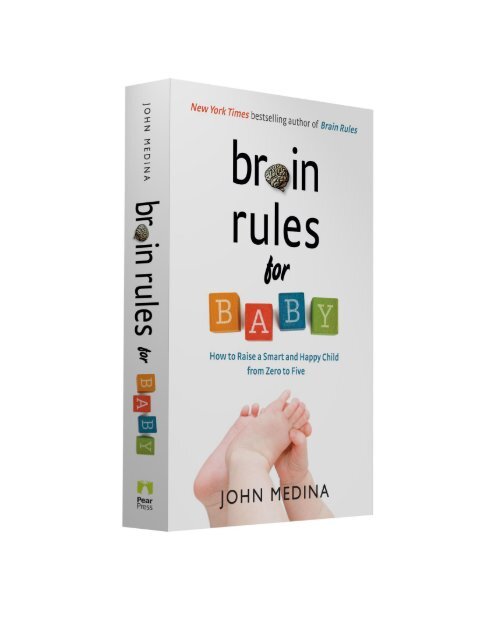
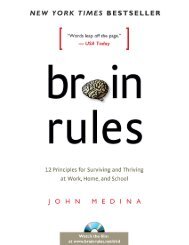
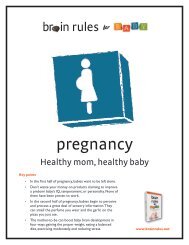
![Chapter Summaries [PDF] - Brain Rules](https://img.yumpu.com/45663759/1/172x260/chapter-summaries-pdf-brain-rules.jpg?quality=85)
